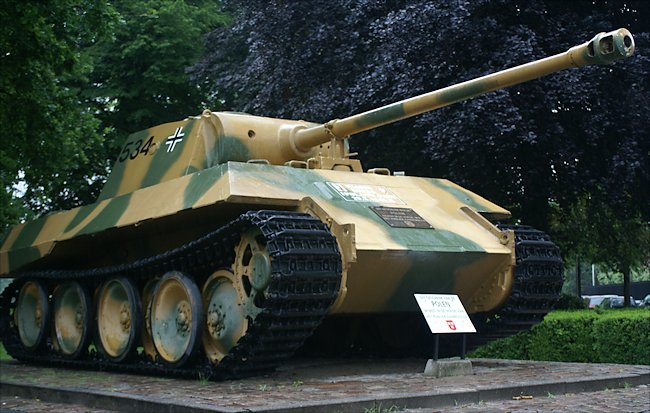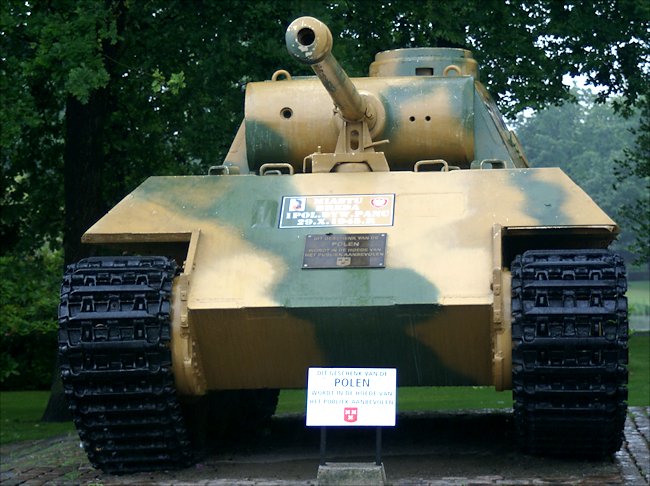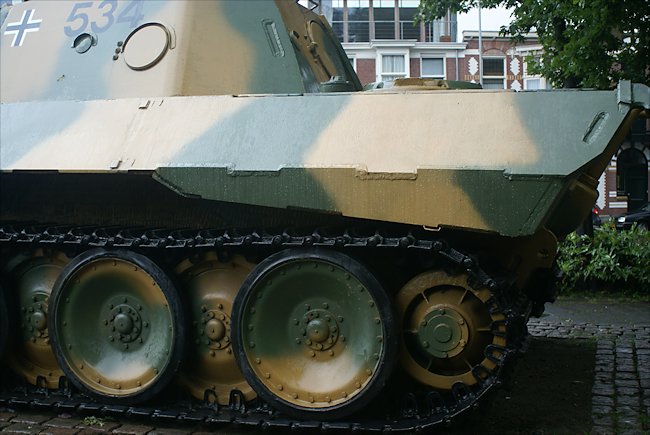Panzer V Panther Tank Ausf. D
This Preserved WW2 German Panzer V Panther Tank Ausf. D can be found in the Dutch city of Breda at the junction of Wilhelminapark and Paule Windhausenweg in Southern Holland.

It was donated by the Troops of the Polish 1st Armoured Division to serve as a memorial of their liberation of Breda in 1944. This Panther is only going to be a memorial. When it was restored by Kevin Wheatcroft in 2004-2005, its interior mechanical parts and engine were removed and used to get another Panther tank back into running order in England.
Sherman tank crews face the Panther
'When it did get light enough to see that the tanks at the bottom of the hill were indeed German Mark V Panthers, I had my gunner, Bob Gladson, lay our gun on the closest German tank. He fired. Our 75mm AP round bounced off the German tank. My loader, Andy Rego, reloaded and we fired again with the same result. I believe we fired three or four rounds of armor piercing ammo at this German tank.'
'None of our rounds caused him any damage. In the meantime, the German tank had picked up our position from the muzzle blast of our tank gun. He laid his gun on our tank and began firing. After my tank was hit, it began to burn, Gladson, Rego, Calvin Bolden and myself were able to get out. Henry Lochowicz, the driver, couldn't get his hatch open as our gun was directly over it. He managed to crawl out through the Commanders hatch in the turret.'

The Panther Tank can kill at 2,000 yards
'We were on the side of a hill and we were, putting brush on to camouflage the tank and I heard Whang! Tambaro's Sherman tank was just above mine, higher on the hill and sideways. And I look out and in the mist I see a German tank, maybe 2,000 yards away and I saw another flash.'
As I saw the other flash, Tambaro goes running by and he had blood and Stuff all over him. I said to myself in my subconscious mind, 'How the hell is he running with his guts all over him?' But it wasn't his. It was the guy next to him, Putnam, I said to Babe Harrell, Knapp's driver, 'Never mind this goddamn brush, let's get the hell out of here' So we pulled out with all the brush still attached.

Phosphorous shells stop a Panther
'I hit a Panther tank one day at least three times with a shell and never touched him,' said Harry. 'He just kept on coming. Then my loader accidentally threw a white phosphorous shell in I hit that tank right in the front end and he stopped'
'They thought they were hit and penetrated and they thought they were on fire. We used the white phosphorous shell for markers. It burns and a puff of white smoke explodes. They were good for hunting range. We had the old type sights where you guessed the range and we used to use what we called bracketing shots. Some gunners would use high explosive to get their bracket.'
'The first shell, you could see it hitting. Now if it would hit, say, 200 yards short, the gunner would raise his elevation 400 yards, and if he shot over the target, then he would drop down 200 yards. That's bracketing. And if you didn't get him the third shot, you'd better find a hole to get into because he was then going to be shooting at you.'
Panther Hunts with bazookas
As in all armies, the combat performance of American troops in every battalion varied greatly. During the Bocage battles, some GIs began to get over their terror of German panzers. Private Hicks of the 22nd Infantry with the 4th Division managed to destroy three Panthers over three days with his bazooka. Although he was killed two days later, confidence in the bazooka as an anti-tank weapon continued to increase.
Colonel Teague of the 22nd infantry heard an account from one of his bazooka men: 'Colonel, that was a great big son-of-a-bitch. It looked like a whole road full of tank. It kept coming on and it looked like it was going to destroy the whole world. I took three shots and the son-of-a-bitch didn't stop.' He paused, and Teague asked him what he did next. 'I ran round behind and took one shot. He stopped.' Some junior officers became so excited by the idea of panzer hunts that they had to be ordered to stop.
Where can I find other preserved Panther Tanks?
- Panther Ausf. A - Wheatcroft Collection, England
- Panther Ausf. A - Befehlspanzer Munster Germany (running condition)
- Panther Ausf. A - (n° 224) Auto + Technik Museum, Sinsheim, Germany
- Panther Ausf. A - (n° 243) Auto + Technik Museum, Sinsheim, Germany
- Panther Ausf. A - (n° 413) Private Collection, Germany
- Panther Ausf. A - (n° 256) Saumur Tank Museum France
- Panther Ausf. A - (n° 211) Saumur Tank Museum France (running condition)
- Panther Ausf. A - Omaha Overlord Museum, Colleville-sur-Mer, France
- Panther Ausf. A - 501/503e RCC Mourmelon-le-Grand France
- Panther Ausf. A - (n° 201) Royal Jordanian Tank Museum, Jordan
- Panther Ausf. A - Australian Armour and Artillery Museum, Cairns, Queensland.
- Panther Ausf. A - National Armor and Cavalry Museum, Fort Benning, GA,USA
- Panther Ausf. A - U.S. Army Ordnance Museum, Fort Lee, VA, USA
- Panther Ausf. A - The Collings Foundation, Stow, MA, USA (running condition)
- Panther Ausf. A - Canadian War Museum (CWM) in Ottawa Canada
- Panther Ausf. A or D Panzermuseum, Thun, Switzerland
- Panther Ausf. D - Breda Netherlands
- Panther Ausf. G - Bovington Tank Museum England (British Built)
- Panther Ausf. G - Wehrtechnische Dienststelle, Trier, Germany (British Built)
- Panther Ausf. G - Privately owned now confiscated by police, Germany (British Built)
- Panther Ausf. G - National War and Resistance Museum, Overloon Netherlands
- Panther Ausf. G - Houffalize Belgium
- Panther Ausf. G - Grandmenil Belgium – engine, gearbox and transmission are present
- Panther Ausf. G - Celles Belgium
- Panther Ausf. G - (n° 332) Saumur Tank Museum France
- Panther Ausf. G - Kubinka Tank Museum Russia (running condition)
- Panther Ausf. G - U.S. Army Ordnance Museum, Fort Lee, VA, USA
- Panther Ausf. G - 2x National Armor and Cavalry Museum, Fort Benning, GA, USA
- Source - Pierre-Oliver Buan - http://the.shadock.free.fr/Surviving_Panzers.html
WW2 tank books

